风险行为
窃听

篡改

假冒

否认

对称加密/共享密钥加密

One-Time Pad/一次性密码本
无条件安全的,理论上绝对无法破译(无穷计算能力计算器遍历密钥空间条件下,无法确定是不是明文)
XOR:A xor B = C , C xor B = A

缺点
- 密匙长度和明文必须等长
- 密匙如何安全的告诉对方(因为上面一点等同于明文如何安全告诉对方,矛盾)
- 密匙要随机不重复
DES(Data Encryption Standard)/3DES
数据加密标准(英语:Data Encryption Standard,缩写为 DES)是一种对称密钥加密块密码算法,1976年被美国联邦政府的国家标准局确定为联邦资料处理标准(FIPS),它基于使用56位密钥的对称算法。
DES现在已经不是一种安全的加密方法,主要因为它使用的56位密钥过短。1999年1月,distributed.net与电子前哨基金会合作,在22小时15分钟内即公开破解了一个DES密钥。虽然在实际中难以应用。为了提供实用所需的安全性,可以使用DES的派生算法3DES来进行加密,虽然3DES也存在理论上的攻击方法。DES标准和3DES标准已逐渐被高级加密标准(AES)所取代。另外,DES已经不再作为国家标准科技协会(前国家标准局)的一个标准
DES-CBC简单实现
1 | func DesCBCEncrypt() ([]bytes, error) { |

Feistel网格结构
费斯妥结构保证了加密和解密过程足够相似—唯一的区别在于子密钥在解密时是以反向的顺序应用的,而剩余部分均相同。这样的设计大大简化了算法的实现,尤其是硬件实现,因为没有区分加密和解密算法的需要
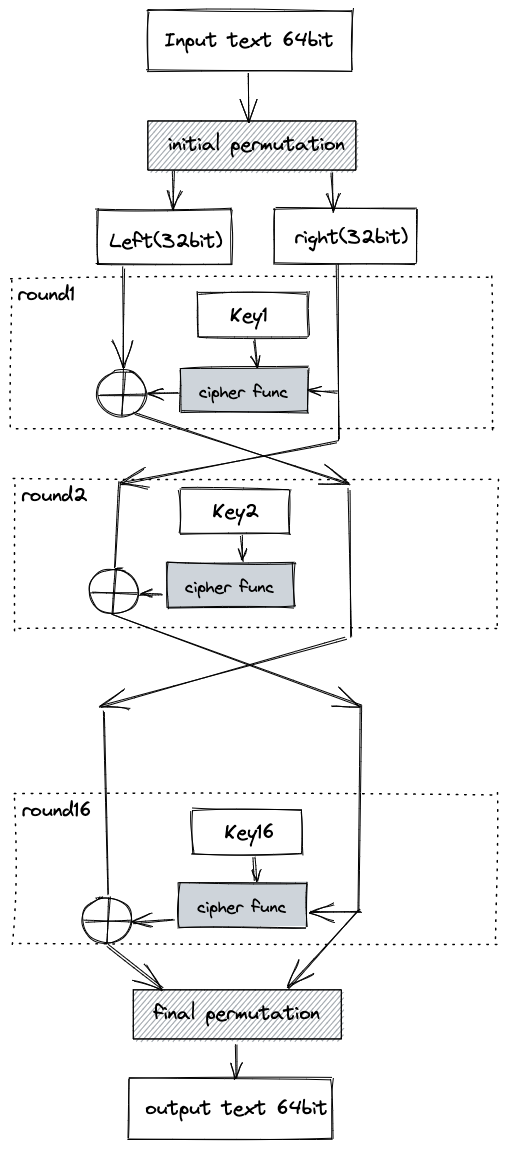
Initial Permutation|初始置换
将64bit打乱
1 | func permuteInitialBlock(block uint64) uint64 { |
feistel函数(cipherFunc)
- 扩张:32位输入通过E扩张,到8个6bit块,每块包含4位对应的输入位,加上两个邻接的块中紧邻的位,共48位
- 混合:上述的48bit结果与48bit key 异或
- s盒处理:将异或结果分为8个6bit块分别输入对应的s盒,8个S盒的每一个都使用以查找表方式提供的非线性的变换将它的6个输入位变成4个输出位。S盒提供了DES的核心安全性—如果没有S盒,密码会是线性的,很容易破解
- 置换:S盒的32个输出位利用固定的置换,“P置换”进行重组。这个设计是为了将每个S盒的4位输出在下一回次的扩张后,使用4个不同的S盒进行处理
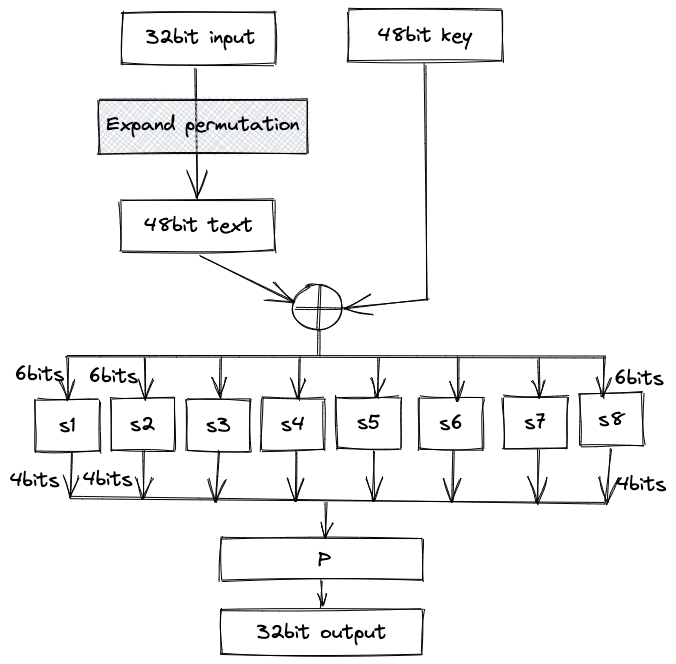
Golang中并没有使用expand,而是采用了另外的方式
1 | // Used to expand an input block of 32 bits, producing an output block of 48 |
密钥置换
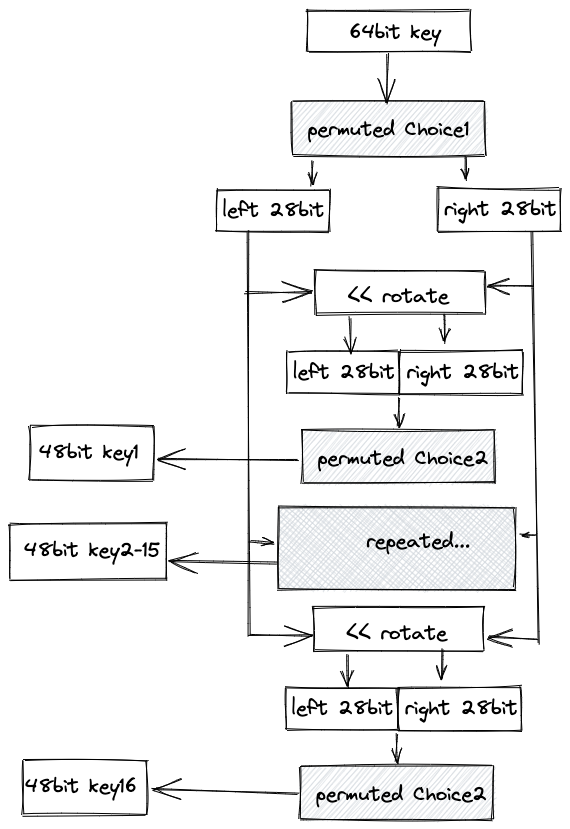
64bit key 通过选择置换1 选出56bit数据
1
2
3
4
5
6
7
8
9
10
11// Used in the key schedule to select 56 bits
// from a 64-bit input.
var permutedChoice1 = [56]byte{
7, 15, 23, 31, 39, 47, 55, 63,
6, 14, 22, 30, 38, 46, 54, 62,
5, 13, 21, 29, 37, 45, 53, 61,
4, 12, 20, 28, 1, 9, 17, 25,
33, 41, 49, 57, 2, 10, 18, 26,
34, 42, 50, 58, 3, 11, 19, 27,
35, 43, 51, 59, 36, 44, 52, 60,
}将置换的数据分为左右28bit,分16轮进入rotate函数分别得到16组旋转后的28bit数据
1
2
3
4
5
6
7
8
9
10
11
12
13
14
15
16
17
18
19// Size of left rotation per round in each half of the key schedule
var ksRotations = [16]uint8{1, 1, 2, 2, 2, 2, 2, 2, 1, 2, 2, 2, 2, 2, 2, 1}
// rotate halves of permuted key according to the rotation schedule
leftRotations := ksRotate(uint32(permutedKey >> 28))
rightRotations := ksRotate(uint32(permutedKey<<4) >> 4)
func ksRotate(in uint32) (out []uint32) {
out = make([]uint32, 16)
last := in
for i := 0; i < 16; i++ {
// 28-bit circular left shift
left := (last << (4 + ksRotations[i])) >> 4
right := (last << 4) >> (32 - ksRotations[i])
out[i] = left | right
last = out[i]
}
return
}将旋转后的left,right组合输入选择置换2,生成48bit subkey用于feistel网格
1
2
3
4
5
6
7// generate subkeys
for i := 0; i < 16; i++ {
// combine halves to form 56-bit input to PC2
pc2Input := uint64(leftRotations[i])<<28 | uint64(rightRotations[i])
// apply PC2 permutation to 7 byte input
c.subkeys[i] = unpack(permuteBlock(pc2Input, permutedChoice2[:]))
}
AES(Advanced Encryption Standard)
高级加密标准(英语:Advanced Encryption Standard,缩写:AES),又称Rijndael加密法(荷兰语发音:[ˈrɛindaːl],音似英文的“Rhine doll”),是美国联邦政府采用的一种区块加密标准。这个标准用来替代原先的DES,已经被多方分析且广为全世界所使用。经过五年的甄选流程,高级加密标准由美国国家标准与技术研究院(NIST)于2001年11月26日发布于FIPS PUB 197,并在2002年5月26日成为有效的标准。现在,高级加密标准已然成为对称密钥加密中最流行的算法之一。
AES-CBC简单实现
1 | func AesEncrypt(plaintext []byte, key, iv []byte) ([]byte, error) { |
AES是Rijndael的一种标准实现,AES blocksize固定128bit,密钥可以为128,192,256bit,Rijindael blocksize和密钥长度均可以为128,192,256
a矩阵代表plaintext 128bit的block,矩阵4X4 每个元素是一个byte
b矩阵是通过Rijndael密钥生成方案将key转化的矩阵
Add Round Key
矩阵中的每一个字节都与该次回合密钥(round key)做XOR运算;每个子密钥由密钥生成方案产生
SubBytes
在SubBytes步骤中,矩阵中的各字节透过一个8位的S-box进行转换。这个步骤提供了加密法非线性的变换能力
ShiftRows步骤
第一列维持不变,第二列里的每个字节都向左循环移动一格。同理,第三列及第四列向左循环位移的偏移量就分别是2和3
MixColumns
Rijndael有限域内的矩阵乘法,主要是让转换后的每个byte依赖于之前整列的byte
有限域计算: wiki
${\left[ \begin{array}{cccc}2 & 3 & 1 & 1\1 & 2 & 3 & 1\1 & 1 & 2 & 3\3 & 1 & 1 & 2\end{array} \right ]}\times{\left[ \begin{array}{cccc}a_{0,0} & a_{0,1} & a_{0,2} & a_{0,3}\ a_{1,0} &a_{1,1} & a_{1,2} & a_{1,3}\ a_{2,0} &a_{2,1} & a_{2,2} & a_{2,3}\ a_{3,0} &a_{3,1} & a_{3,2} & a_{3,3}\end{array}\right ]}={\left[ \begin{array}{cccc}r_{0,0} & r_{0,1} & r_{0,2} & r_{0,3}\ r_{1,0} &r_{1,1} & r_{1,2} & r_{1,3}\ r_{2,0} &r_{2,1} & r_{2,2} & r_{2,3}\ r_{3,0} &r_{3,1} & r_{3,2} & r_{3,3}\end{array}\right ]}$
1 | r00 = 2*a00 ^ 3*a10 ^ 1*a20 ^ 1*a30 |
[证明过程]
Early Bounds Check
1 |
|
减少CX寄存器的 CMPQ指令


对特定CPU aes加密是直接用优化后的汇编代码执行
1 | var supportsAES = cpu.X86.HasAES || cpu.ARM64.HasAES |
Padding方案
RFC 2315 PKCS #7: Crytographic Message Syntax March 1998
Some content-encryption algorithms assume the
input length is a multiple of k octets, where k > 1, and
let the application define a method for handling inputs
whose lengths are not a multiple of k octets. For such
algorithms, the method shall be to pad the input at the
trailing end with k - (l mod k) octets all having value k -
(l mod k), where l is the length of the input. In other
words, the input is padded at the trailing end with one of
the following strings:
01 -- if l mod k = k-1
02 02 -- if l mod k = k-2
.
.
.
k k ... k k -- if l mod k = 0
The padding can be removed unambiguously since all input is
padded and no padding string is a suffix of another. This
padding method is well-defined if and only if k < 256;
methods for larger k are an open issue for further study.

PKCS5是 blocksize=8的PKCS7
zeroPadding是末尾固定用0补位
1 | //golang实现 |
分组模式
EBC(electronic code book)/电子密码本
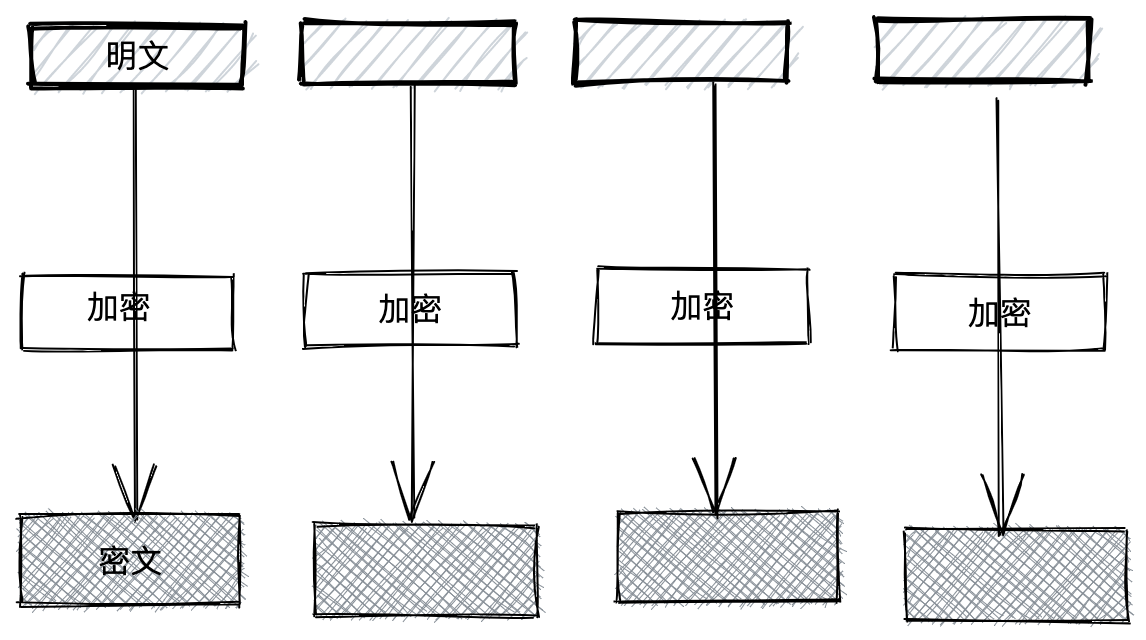
优点:
- 简单
- 快速
- 支持并行
缺点:
- 无需解密就可对明文进行操作(如交换密文分组,删除密文分组等)
- 明文中的重复可以体现在密文中
案例:比如A给B汇款,可以通过修改密文顺序变更成B给A汇款
CBC(cipher block chaining)/密文分组链接
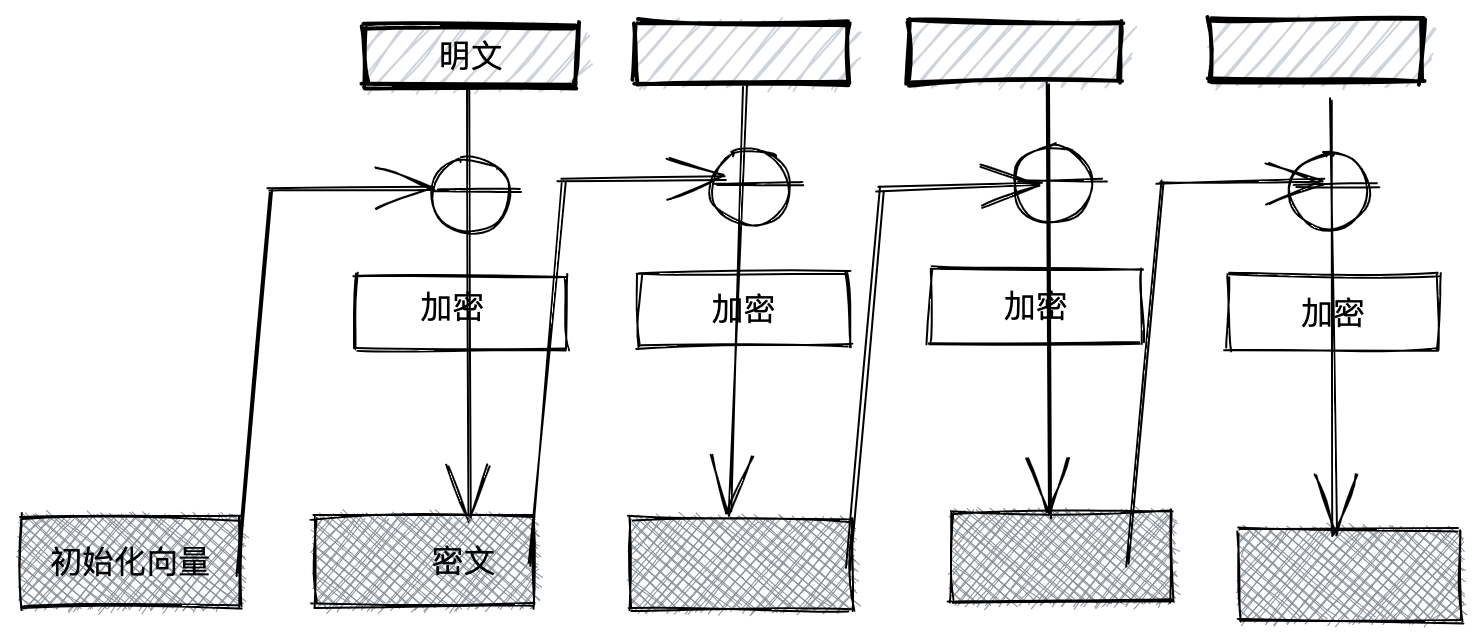
优点
- 明文重复不影响密文
- 解密支持并行
缺点:
- 加密不支持并行
CTR(CounTeR)/计数器模式
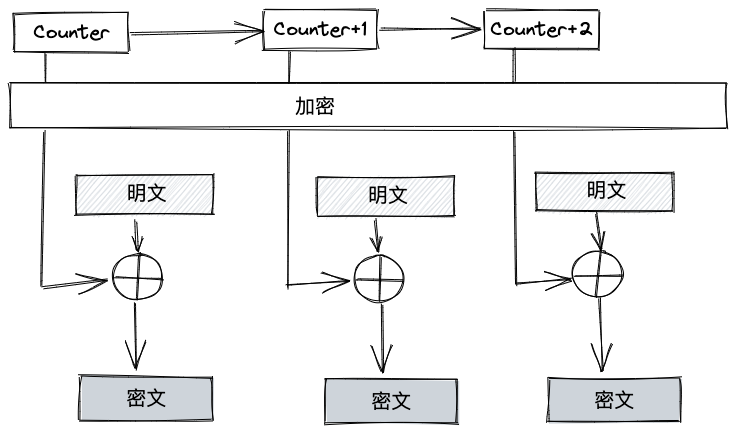
对称加密需要解决的问题就是密钥如何安全发送给接收者(蛋生鸡鸡生蛋)

以此衍生的技术是:
- 非对称加密
- 密钥交换(Diffie-Hellman)
非对称加密/公钥加密


加密用公钥加密,解密用私钥
RSA
加密
$ciphertext = plaintext^E \% N$
解密
$plaintext = ciphertext^D\%N$
公钥:(N,E) 私钥:(N,D)
步骤
- N=pq, pq为大素数且p≠q
- $R = \varphi(N)=\varphi(p)*\varphi(q) = (p-1)p^0(q-1)q^0=(p-1)(q-1)$,求N的欧拉函数值
- 选择一个小于r的整数E,使E与R互质。并求得E关于R的模逆元,命名为D 即(E*D)%R=1
处理速度是对称加密的几百分之一
中间人攻击

- B发送pubB公钥给A,被X截获,然后X将自己的pubX发给A
- A以为pubX是B的公钥,用pubX加密内容发送给B
- X窃取A发送的内容,用priX解密,获得明文
- X修改内容,用pubB加密发送给B
- B用priB解密以为是A发送的内容,实际是X发送的内容
消息认证码(Message Authentication Code/MAC)

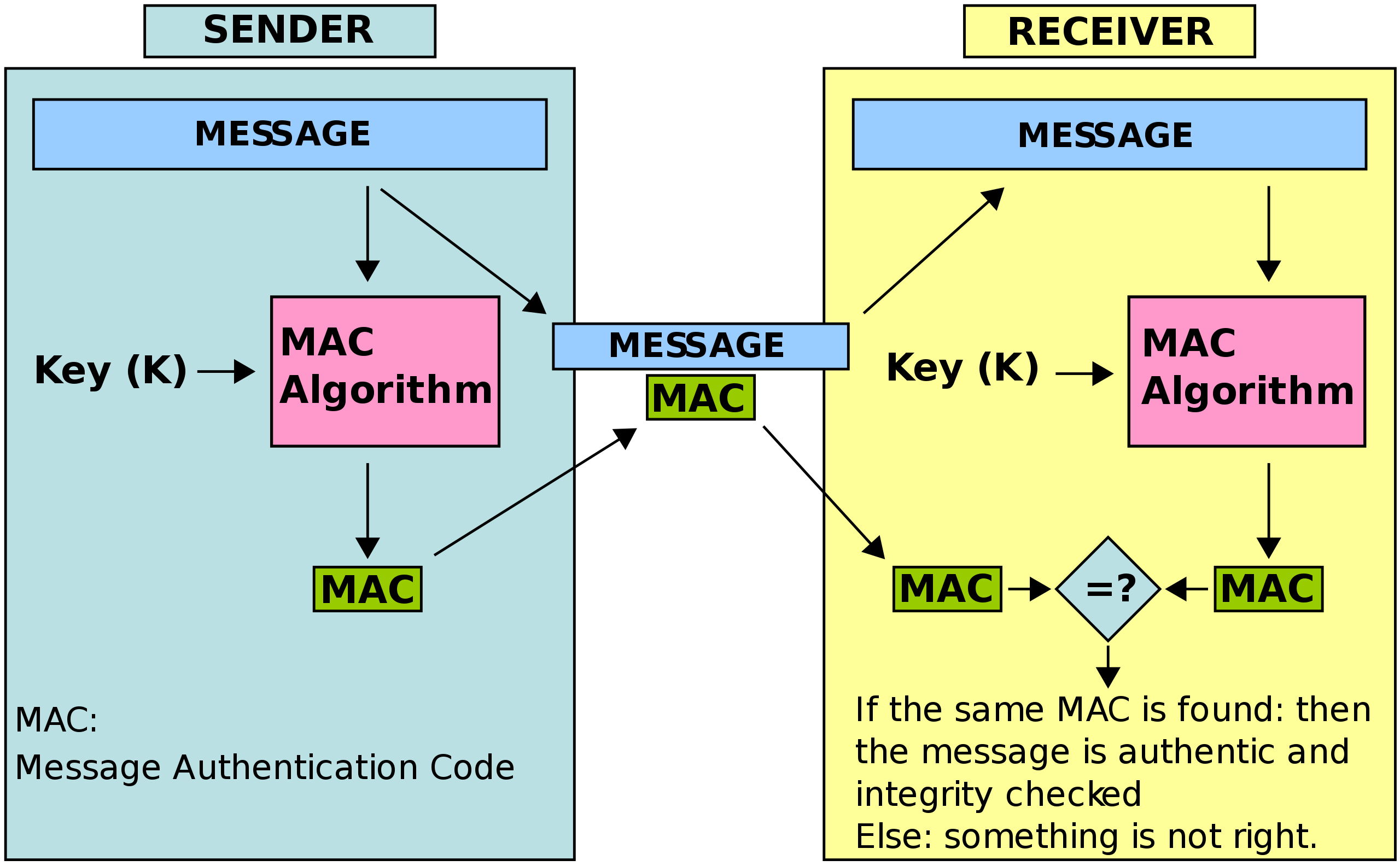
单向散列函数
特性
- 任意输入输出长度固定
单向性
对于每一个输入,函数值都容易计算(多项式时间);但是对于一个随机的函数值,算出其对应的输入却比较困难(无法在多项式时间内使用确定性图灵机计算)。 单向函数是否存在仍然是计算机科学中的一个开放性问题
碰撞抗性
- 弱碰撞抗性:Given an input m1, it should be difficult to find a different input m2 such that hash(m1) = hash(m2)
- 强碰撞抗性:It should be difficult to find two different messages m1 and m2 such that hash(m1) = hash(m2).
常用算法
- MD5
- SHA-1, SHA-2(SHA-256,SHA-384,SHA-512),SHA-3
MD5 由Ronald Rivest于 1991年设计以取代早期的散列函数 MD4,并于 1992 年指定为 RFC 1321。与 MD5 的冲突可以在几秒钟内计算出来,这使得该算法不适用于大多数需要加密散列的用例。MD5 生成 128 位(16 字节)的摘要。
2005年,密码分析人员发现了对SHA-1的有效攻击方法,这表明该算法可能不够安全,不能继续使用
HMAC (Hash MAC)
rfc2104:
We define two fixed and different strings ipad and opad as follows
(the 'i' and 'o' are mnemonics for inner and outer):
ipad = the byte 0x36 repeated B times
opad = the byte 0x5C repeated B times.
To compute HMAC over the data `text' we perform
H(K XOR opad, H(K XOR ipad, text))
H 是加密哈希函数(任何加密用散列函数,比如sha家族)
m是要认证的消息
K是密钥
K '是从密钥K派生的块大小的密钥;要么用 0 向右填充到块大小,要么先散列到小于或等于块大小,然后用零填充到右边
‖ 表示串联
⊕ 表示按位异或(XOR)
opad是块大小的外部填充,由值为 0x5c 的重复字节组成
ipad是块大小的内部填充,由值为 0x36 的重复字节组成
数字签名

生成签名
$signature = plaintext^D \% N$
验证
$plaintext = signature^E\%N$

如何确定B的pubA就是A生成的?
数字证书



- A用生成的pubA想CA(证书认证机构)注册
- CA用自己的私钥生成数字签名
- A发送证书给B
- B通过CA的pubC验证证书是否合法
- 合法后提取pubA
随机数
随机数围绕3个特性,越往下越难实现。
- 随机性:不存在统计学偏差,杂乱无章 (弱伪随机)
- 不可预测:不能通过过去的数推到下一个数 (密码学安全伪随机,强伪随机)
- 不可重现
其定义为随机样本不可重现。实际上只要给定边界条件,真随机数并不存在,可是如果产生一个真随机数样本的边界条件十分复杂且难以捕捉(比如当地的背景辐射波动值),可以认为用这个方法演算出来了真随机数。但实际上,这也只是非常接近真随机数的伪随机数,一般认为,无论是背景辐射、物理噪音、抛硬币等等都是可被观察了解的,任何基于经典力学产生的随机数,都只是伪随机数。
伪随机
线性同余生成器/Linear congruential generator(LCG)
$$X_{n+1} = (aX_n+c) \%m$$
线性同余方法可见C的rand和java的util.Random方法
c的rand还包含了线性累加反馈法,即LAFM(linear additive feedback method)的实现具体使用取决于state状态
1 | // a = 1103515245, c = 12345, m = 2^31 |
1.必须遍历2^31后才能轮到"同一个"数
2.具有周期性,不具备不可预测性
单向散列函数/密码法/etc
"真“随机(密码安全伪随机)
在linux系统,crypto/rand 使用syscall获取信息熵来作为随机数,可以在密码学上认为接近真随机
1 | // golang: crypto/rand |
od -vAn -N4 -tu4 < /dev/urandom
可以使用od工具查看urandom产生的结果
Linear congruential generator - Wikipedia
@https://m.sohu.com/n/476868293/?wscrid=95360_2
@[https://www.mscs.dal.ca/~selinger/random/](https://www.mscs.dal.ca/~selinger/random/)







